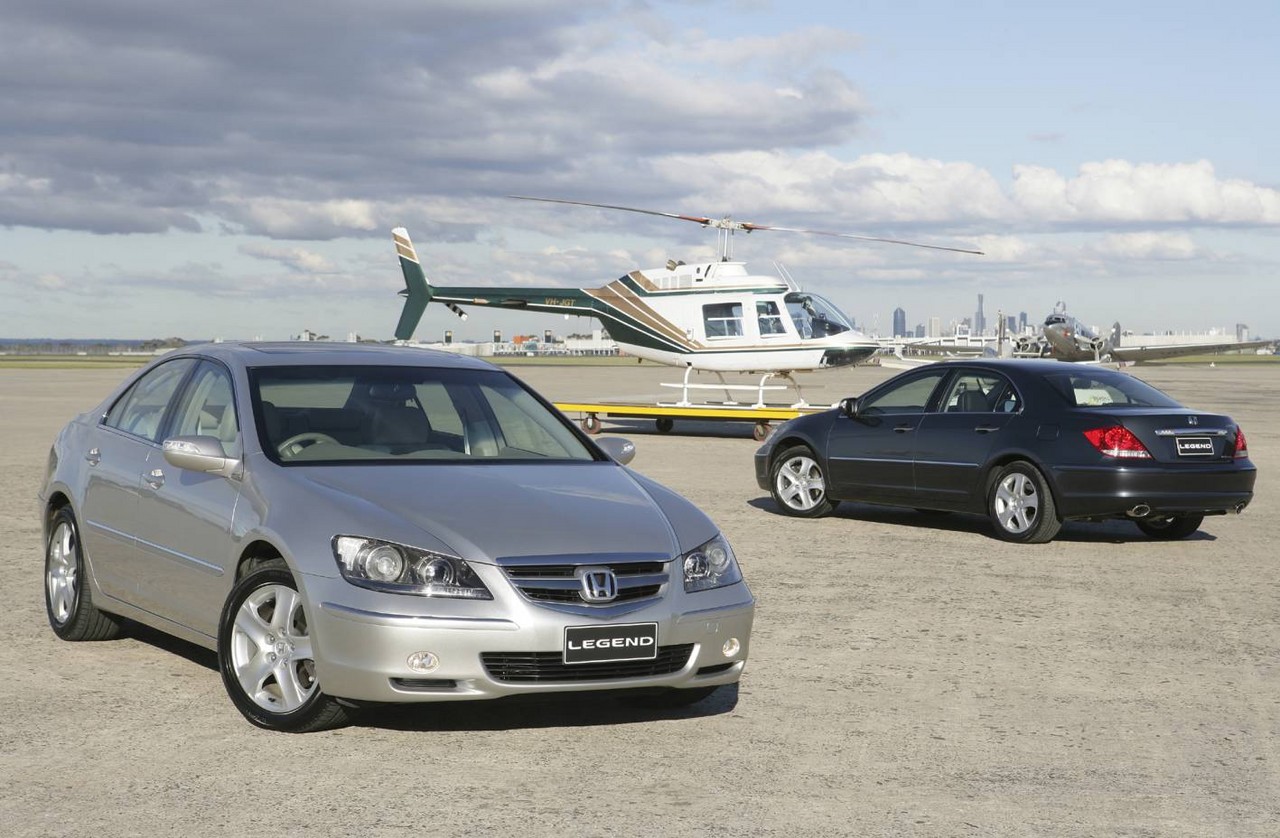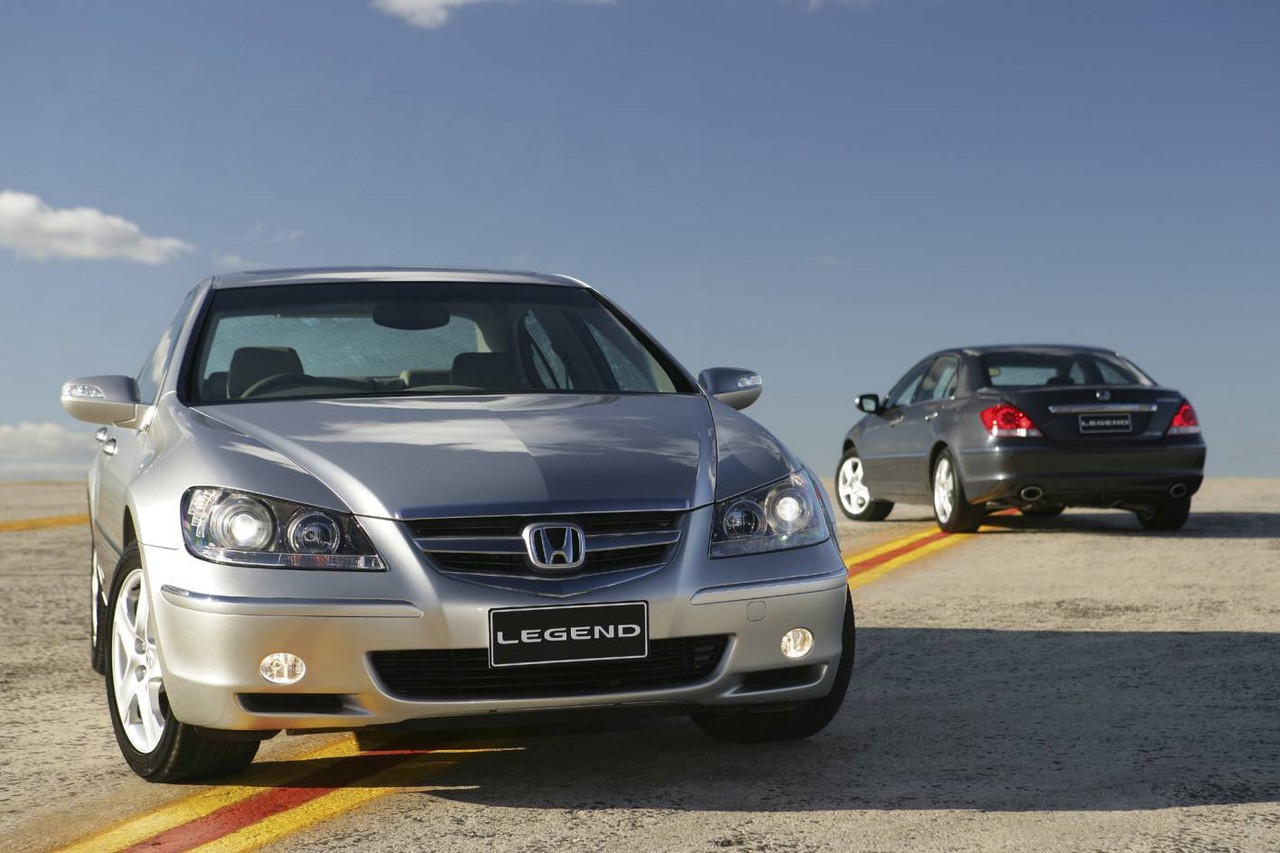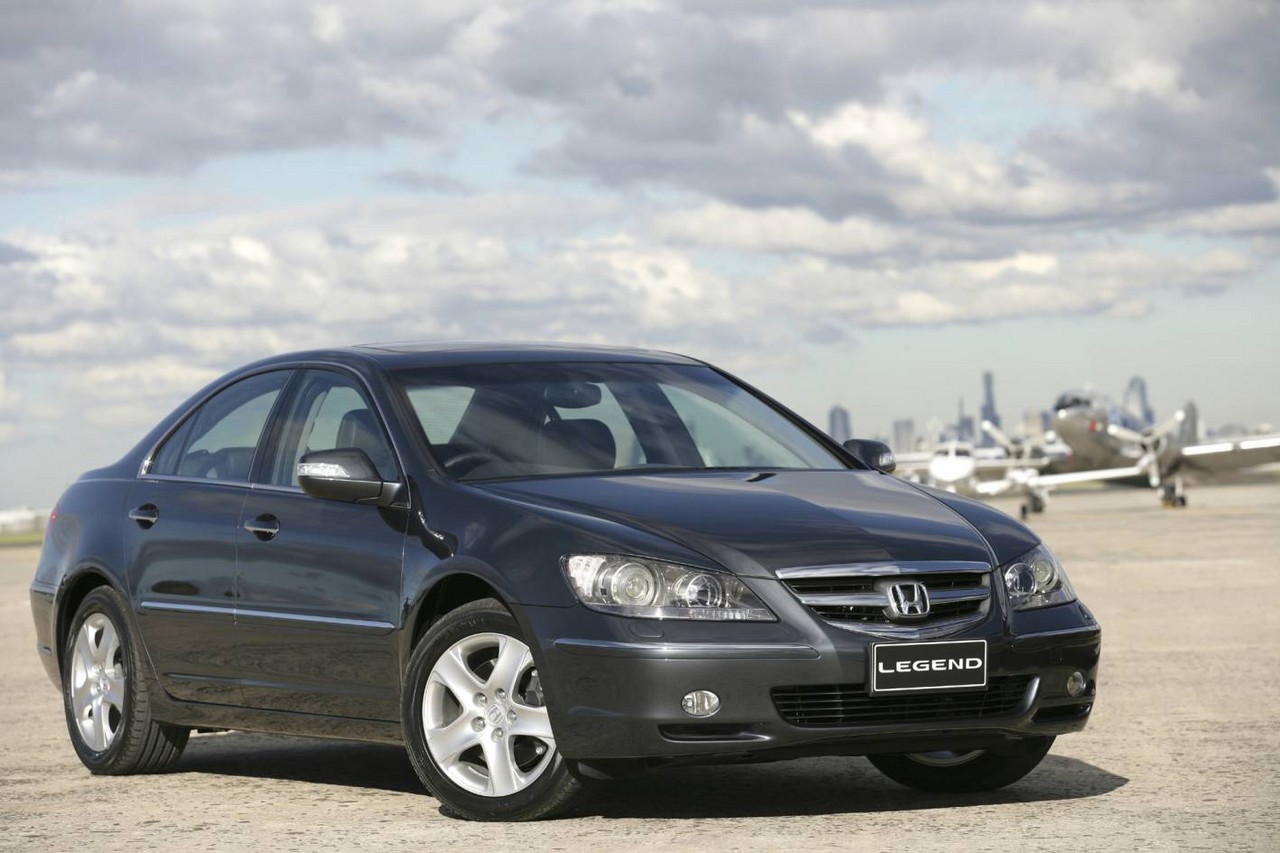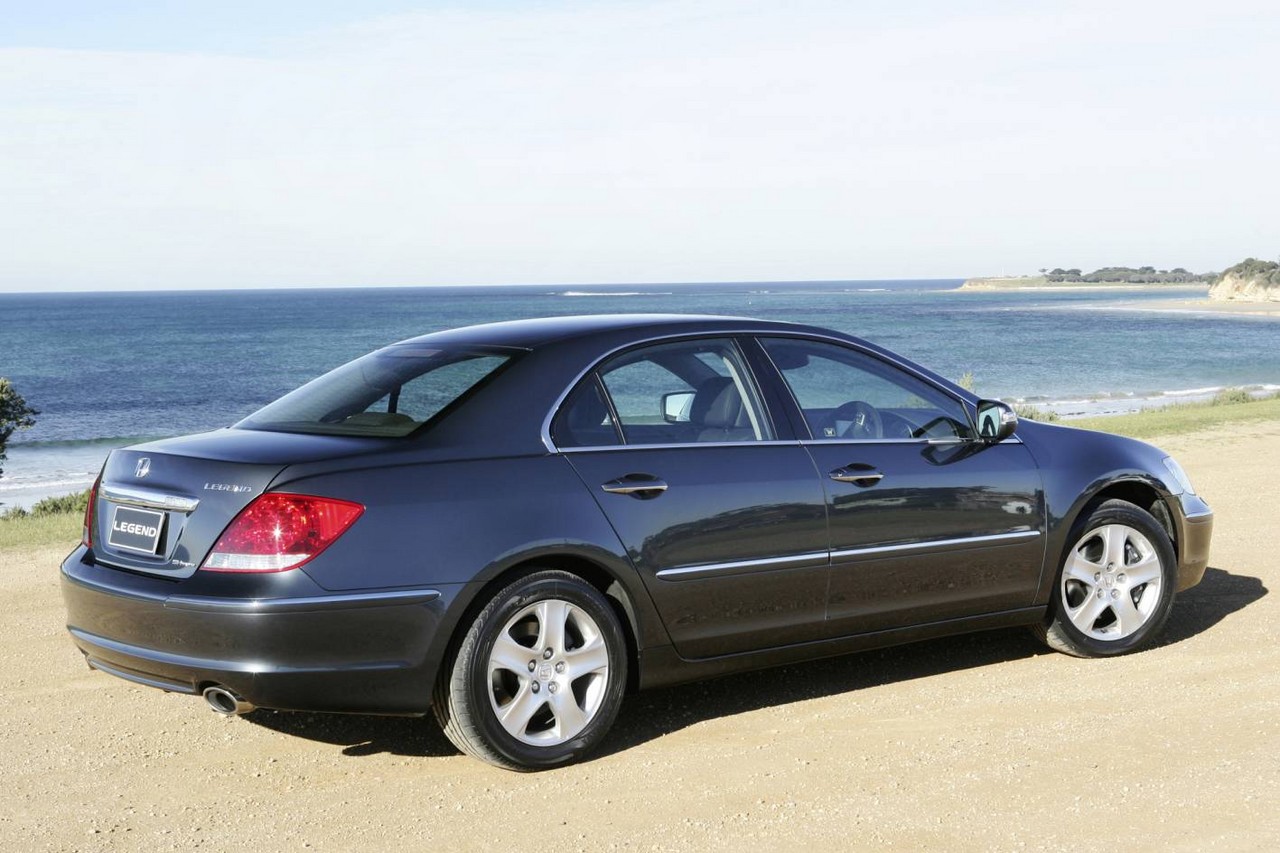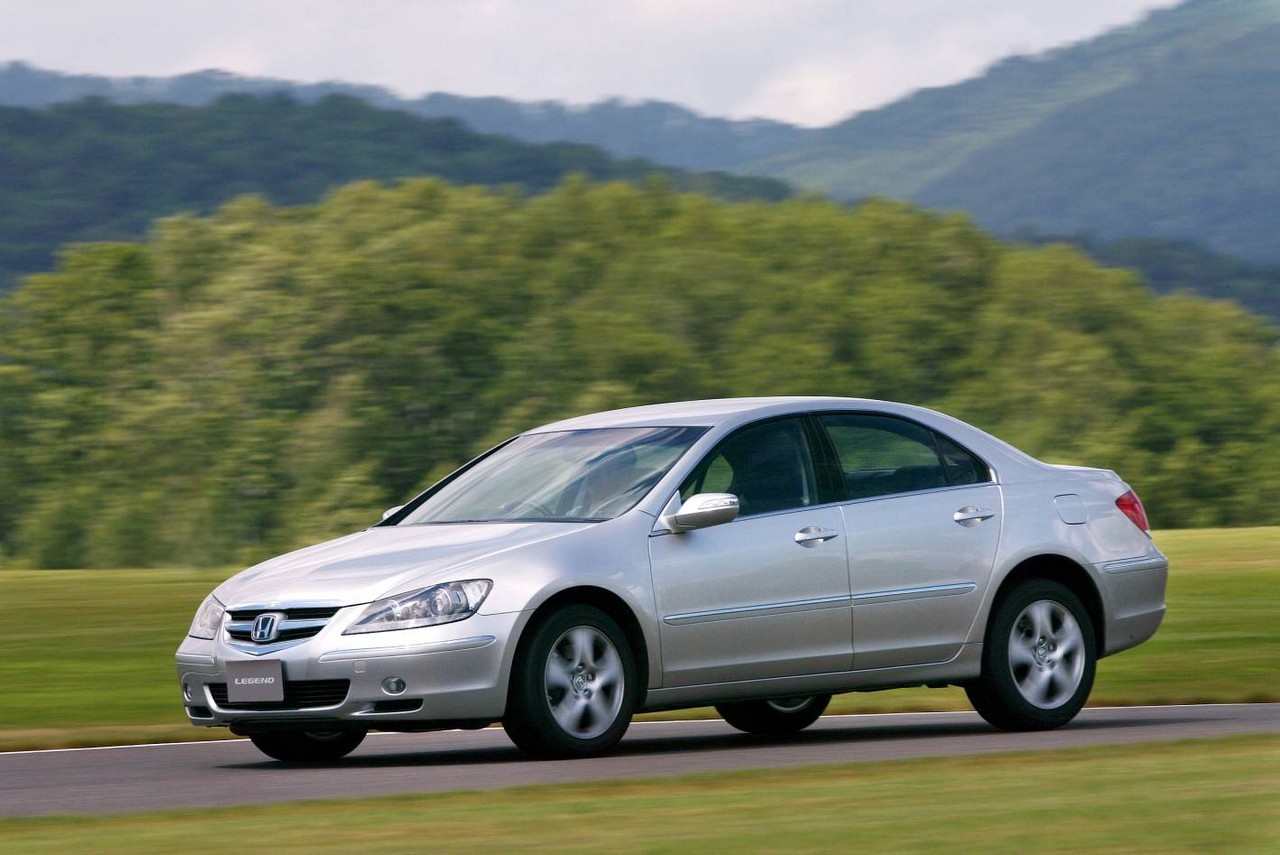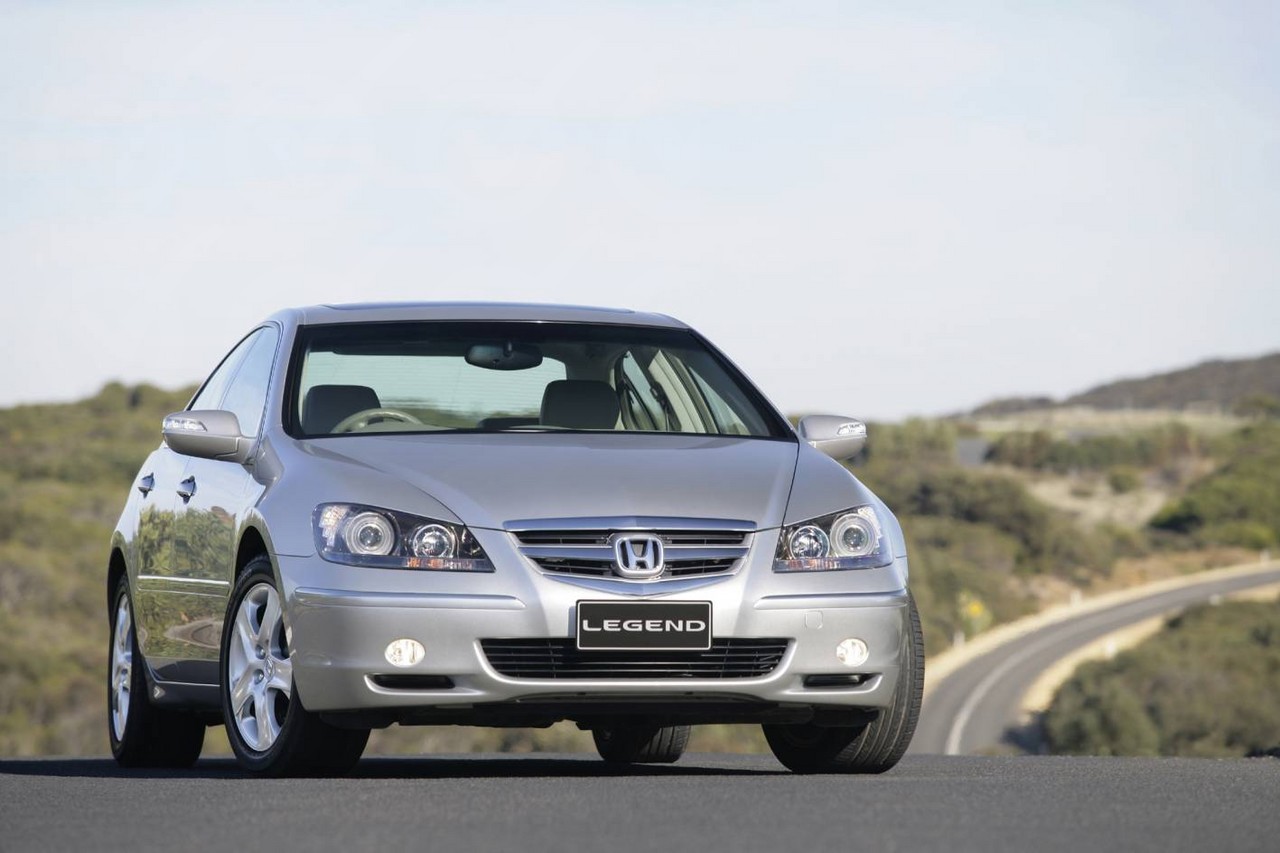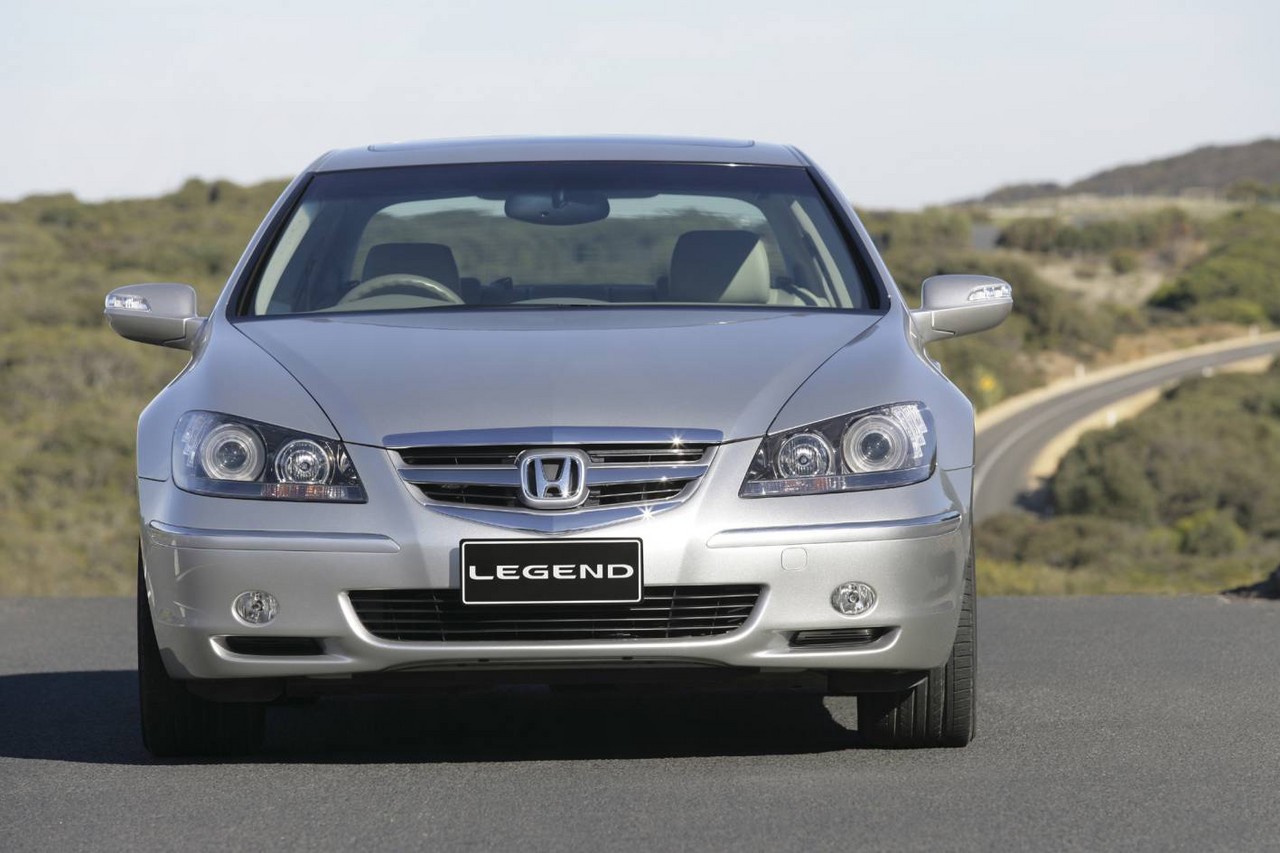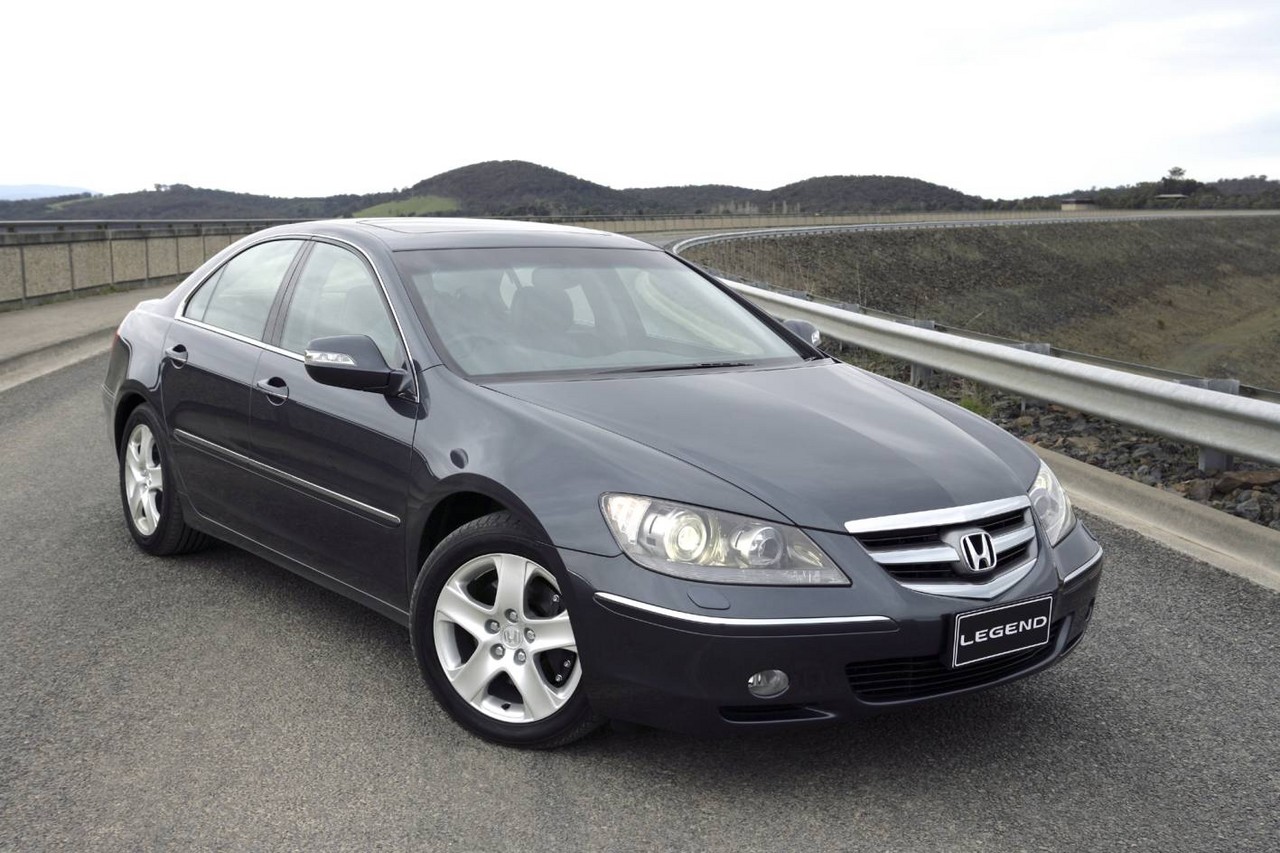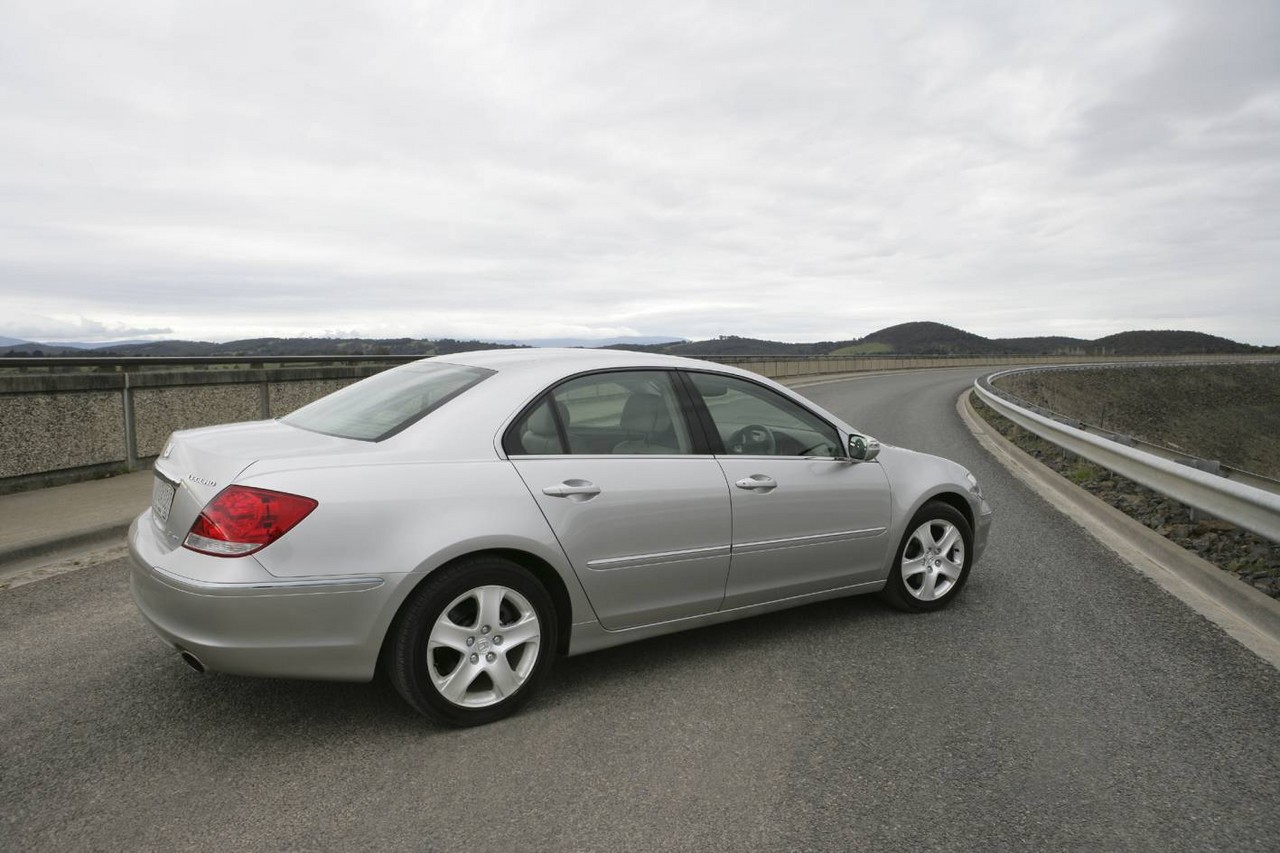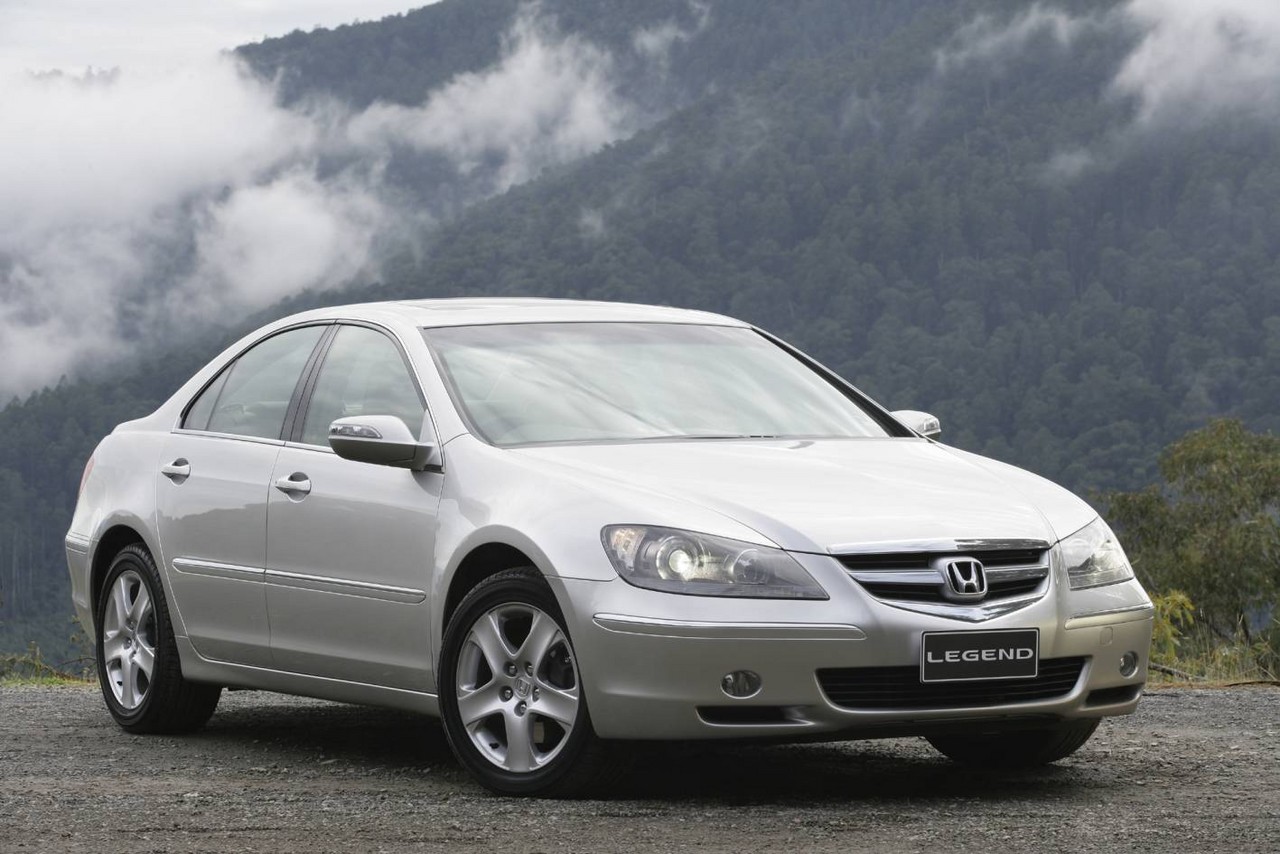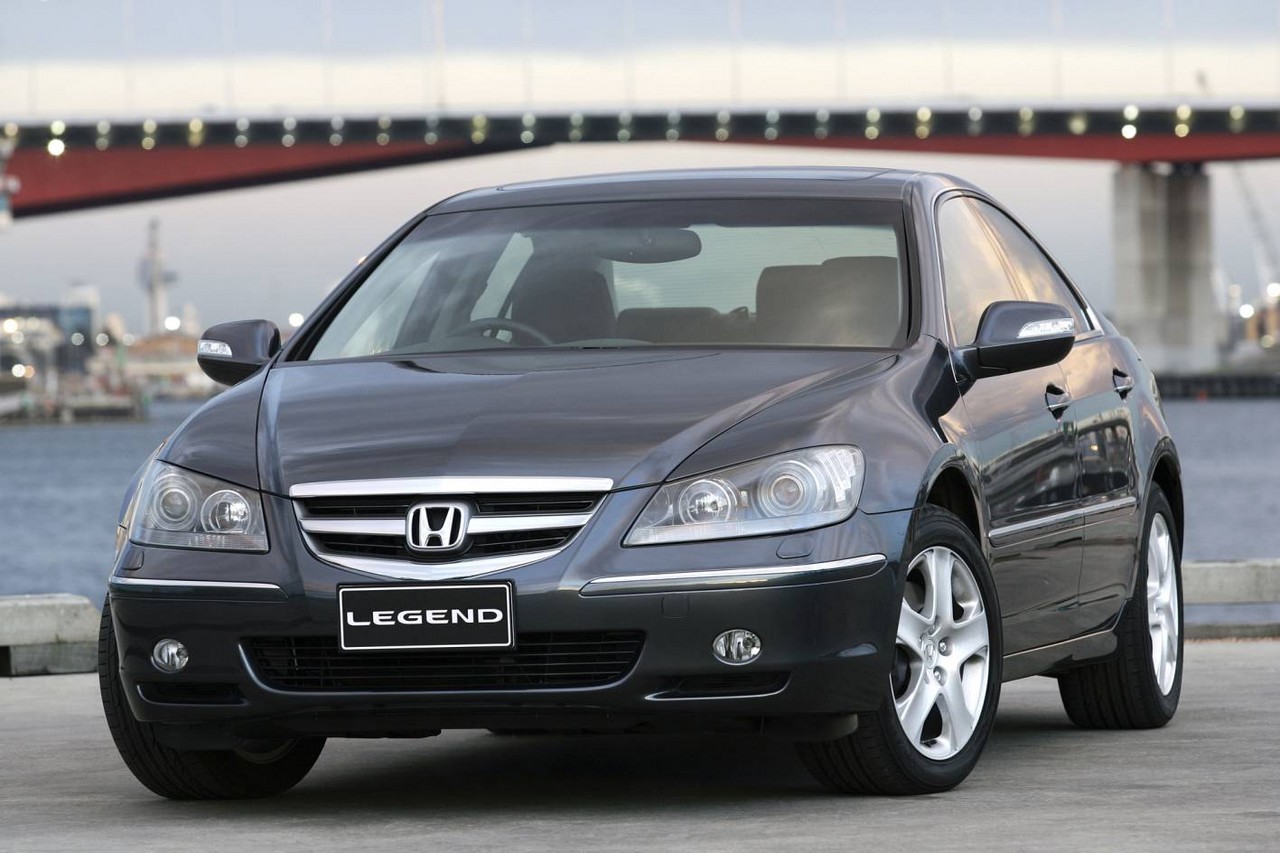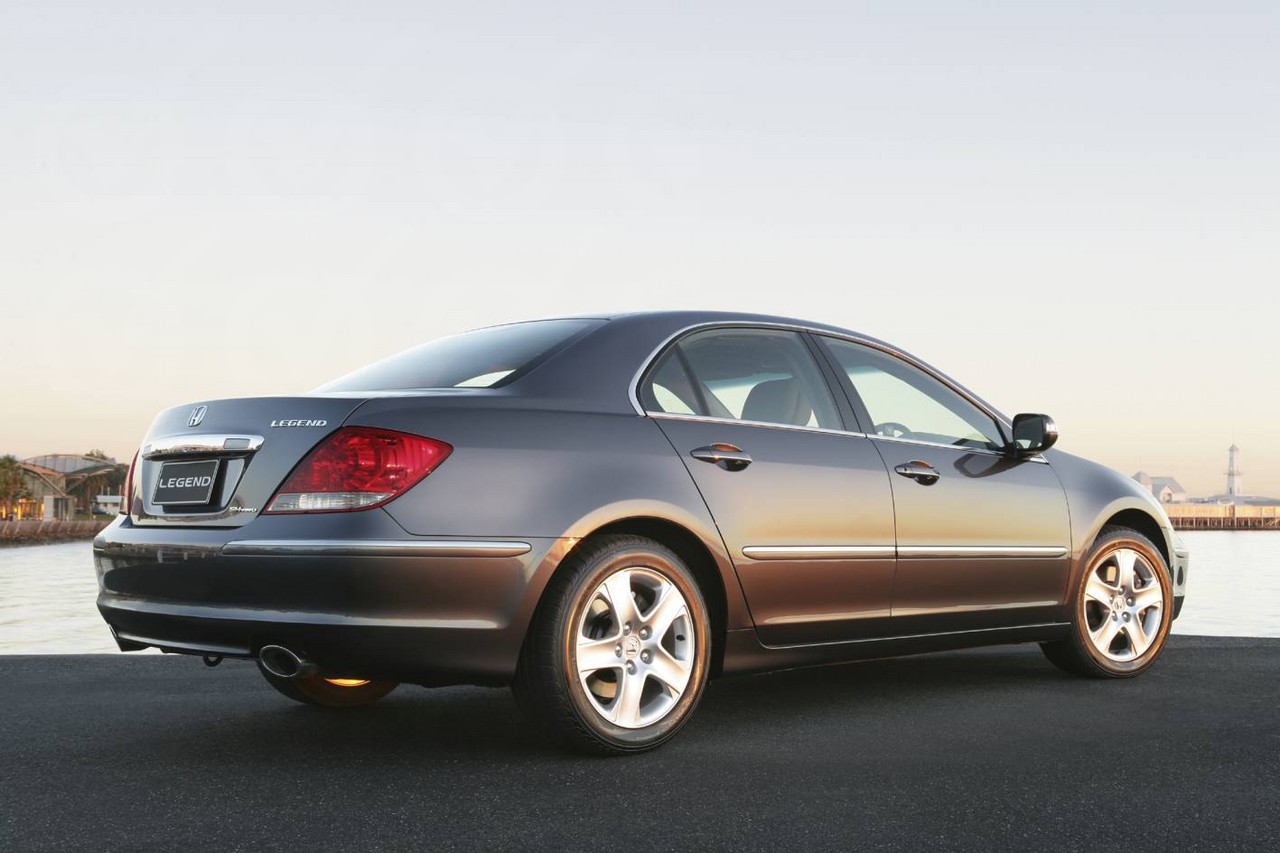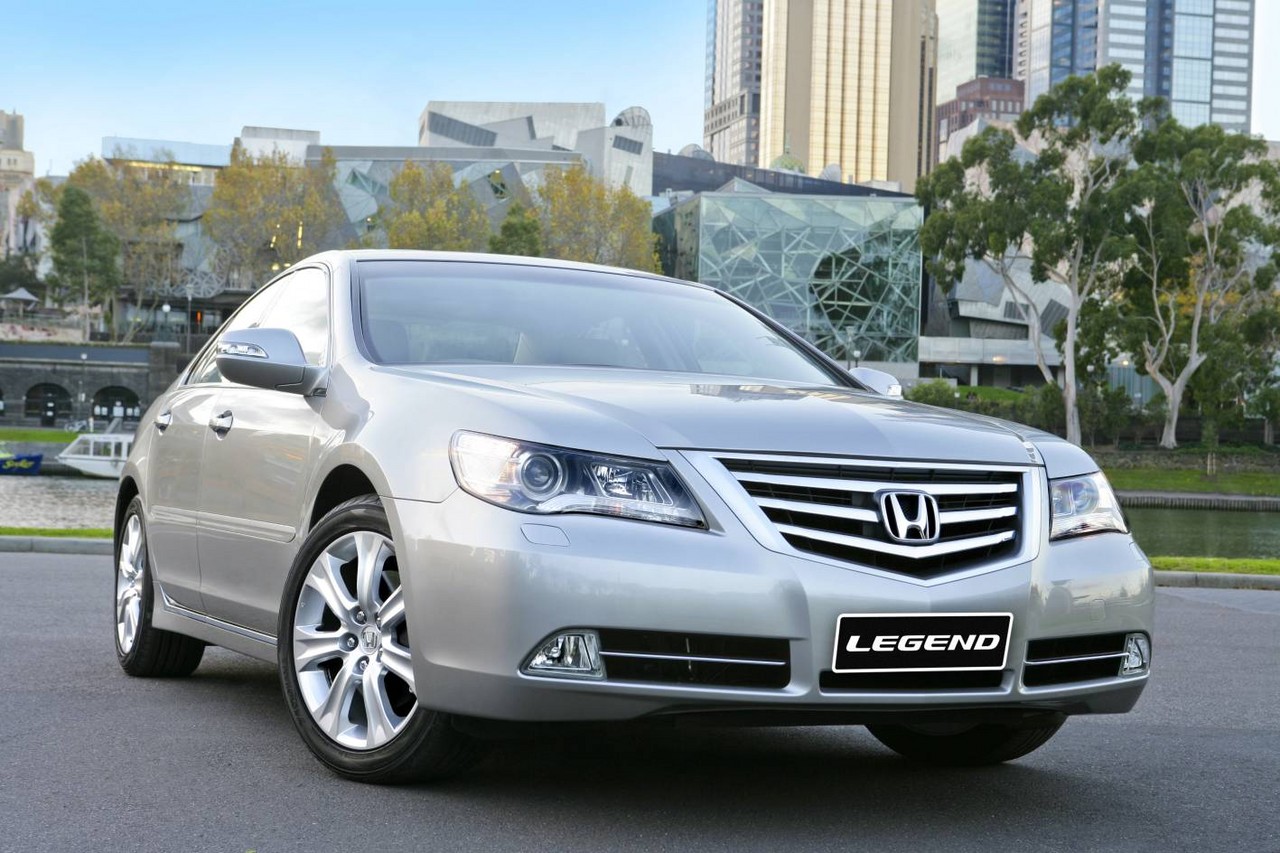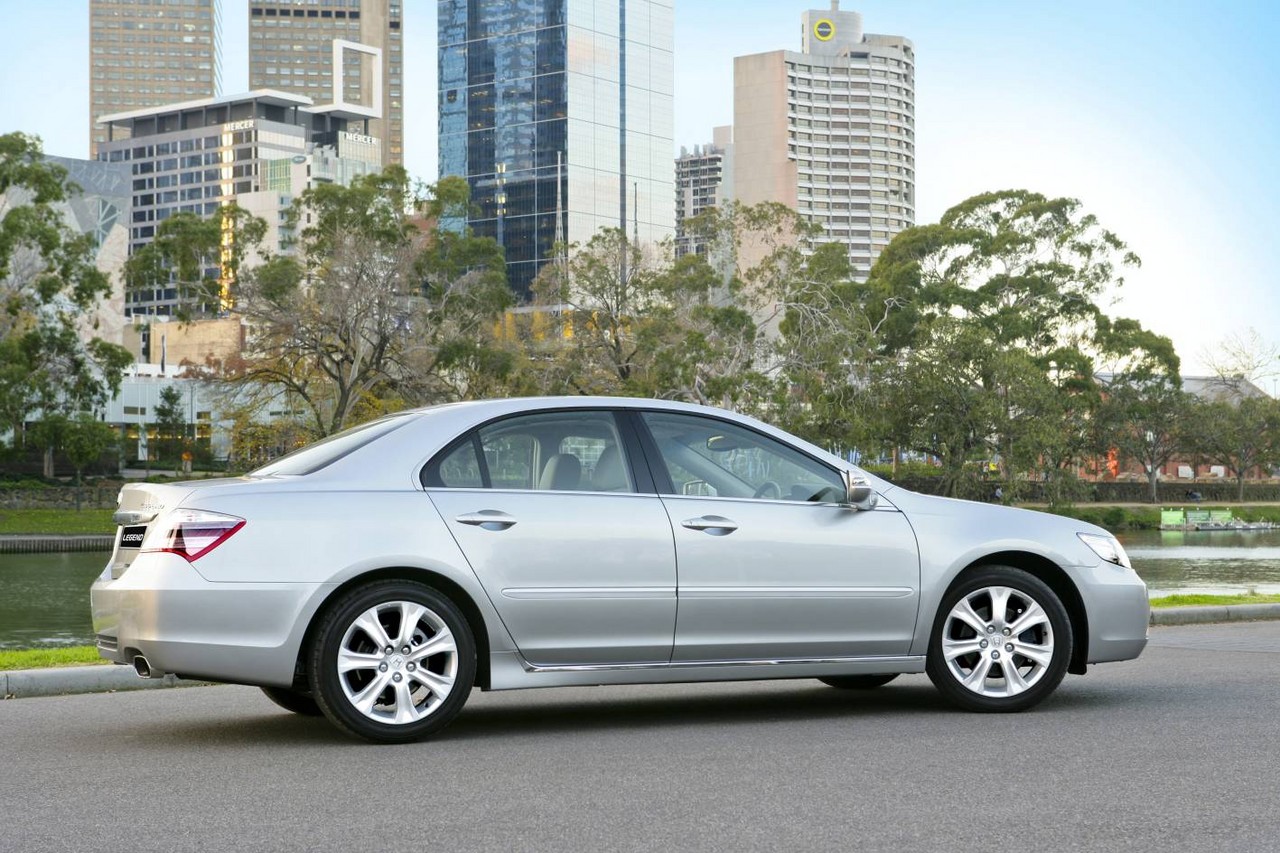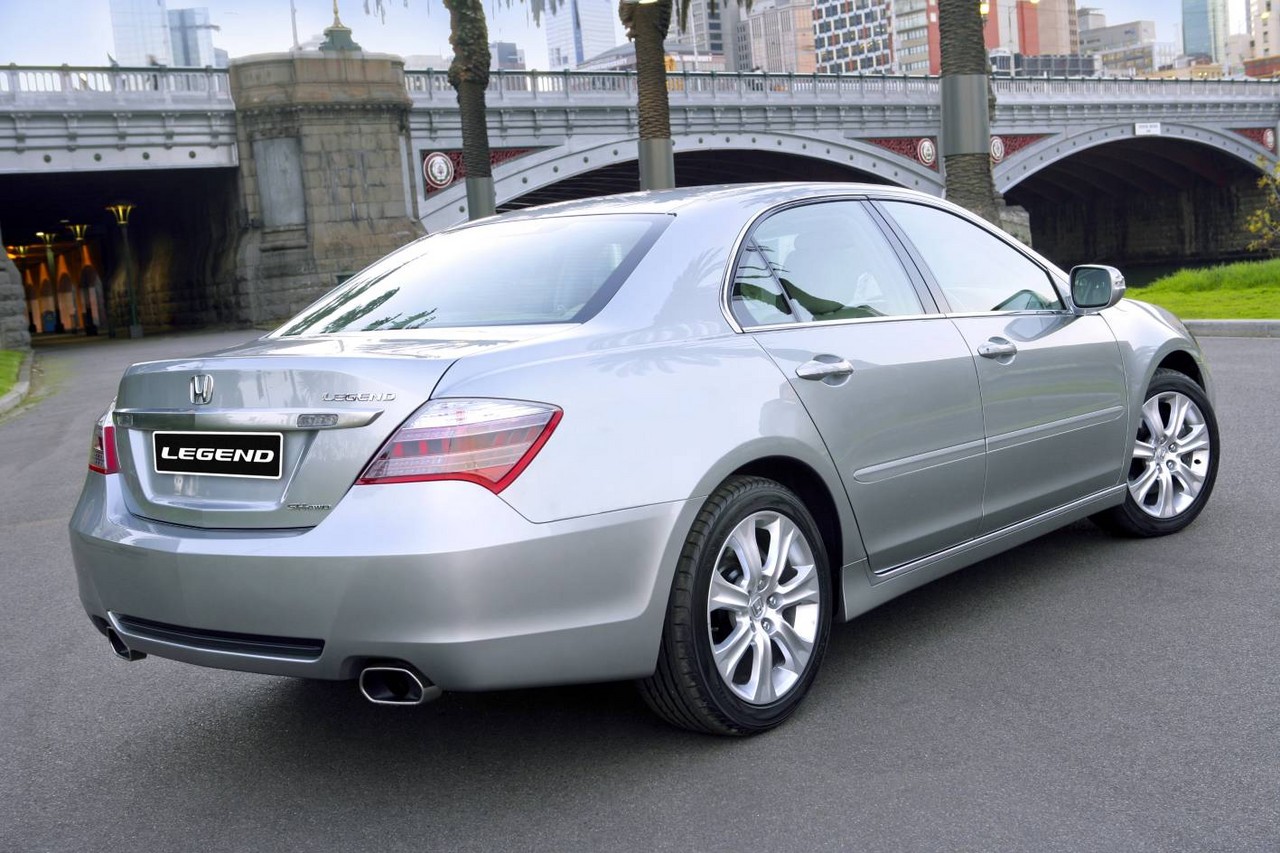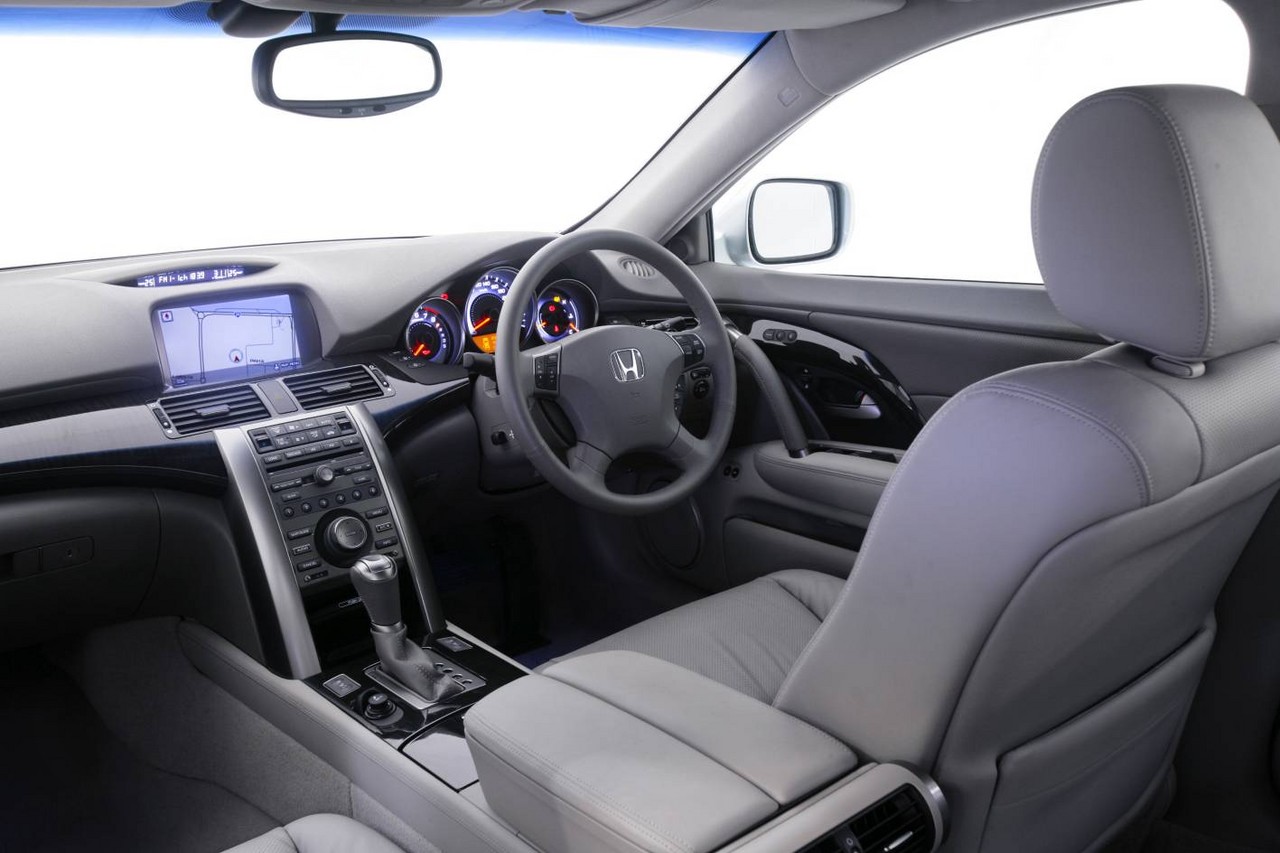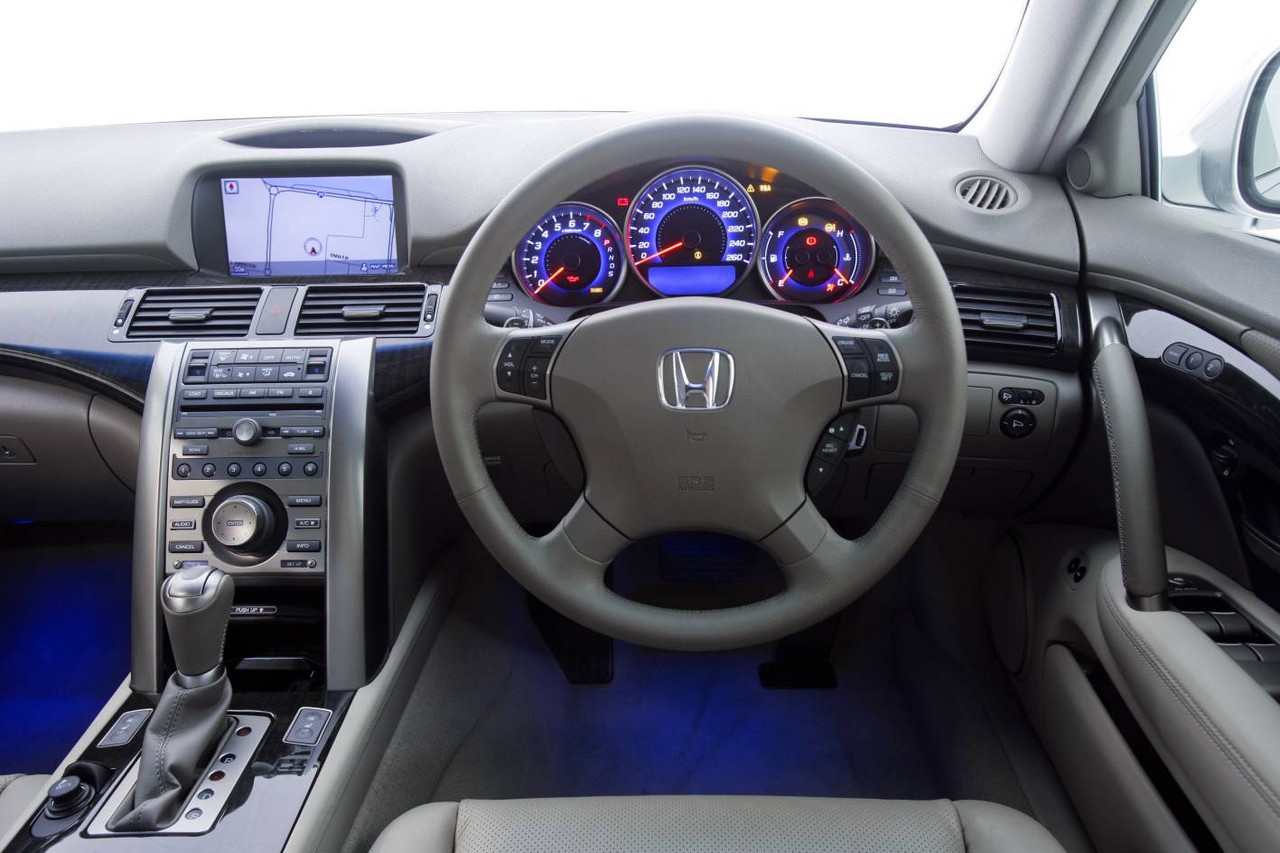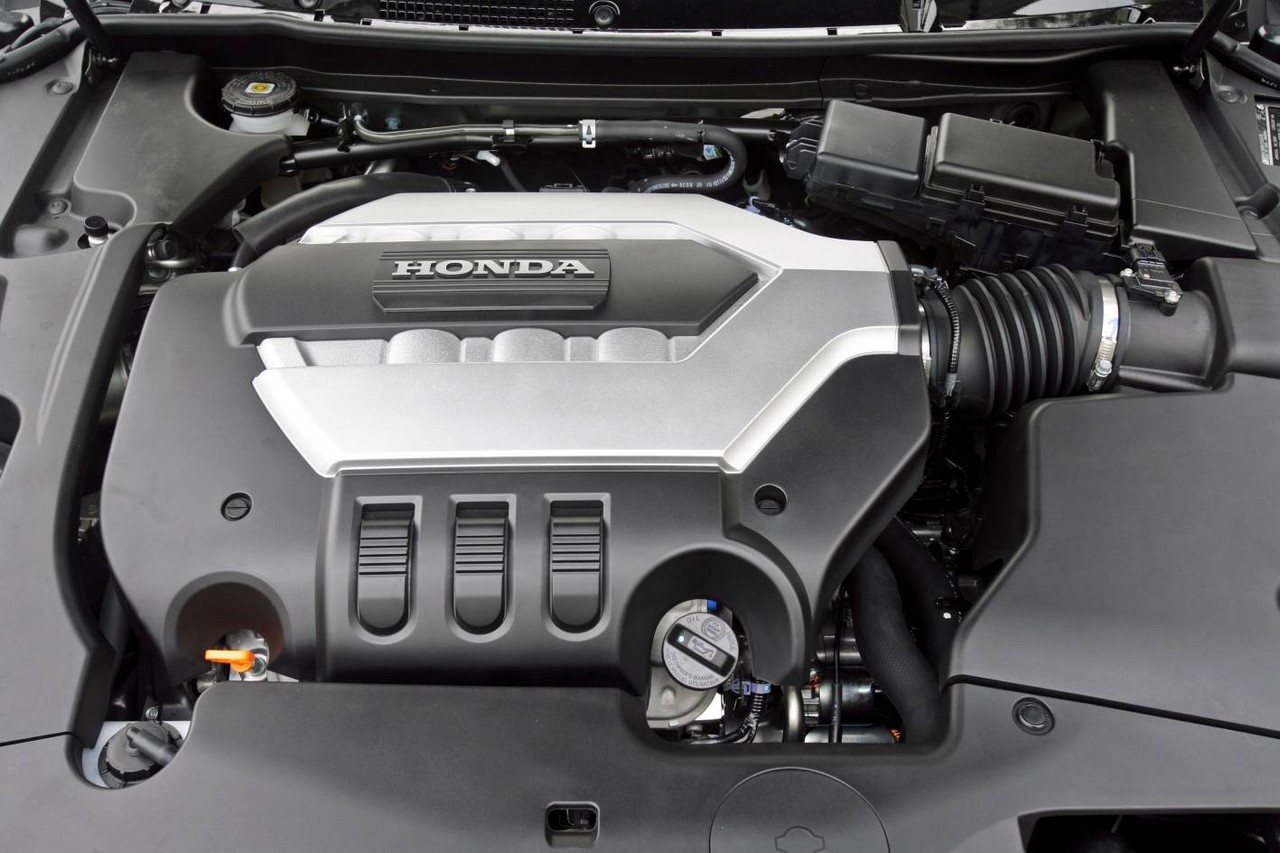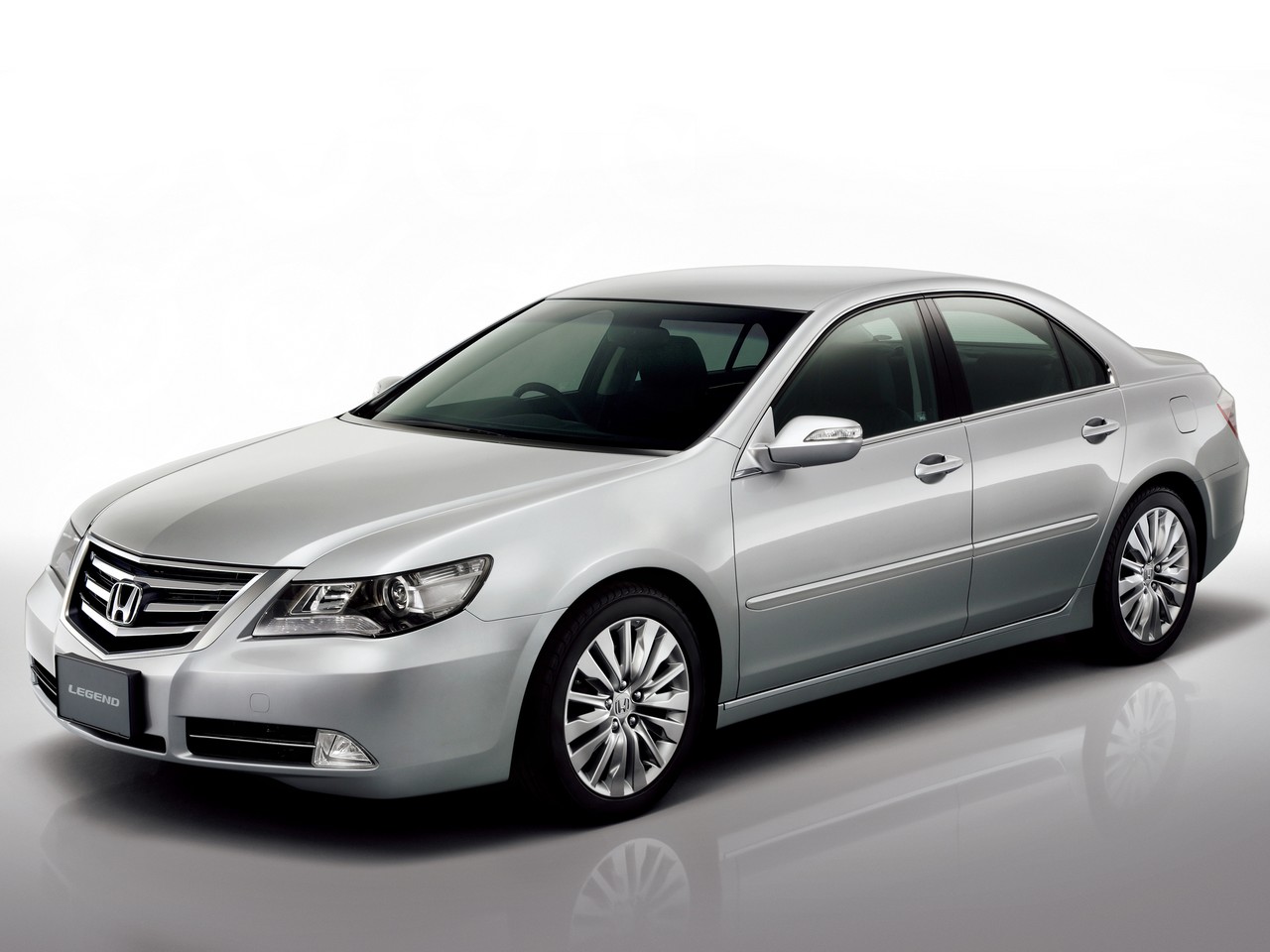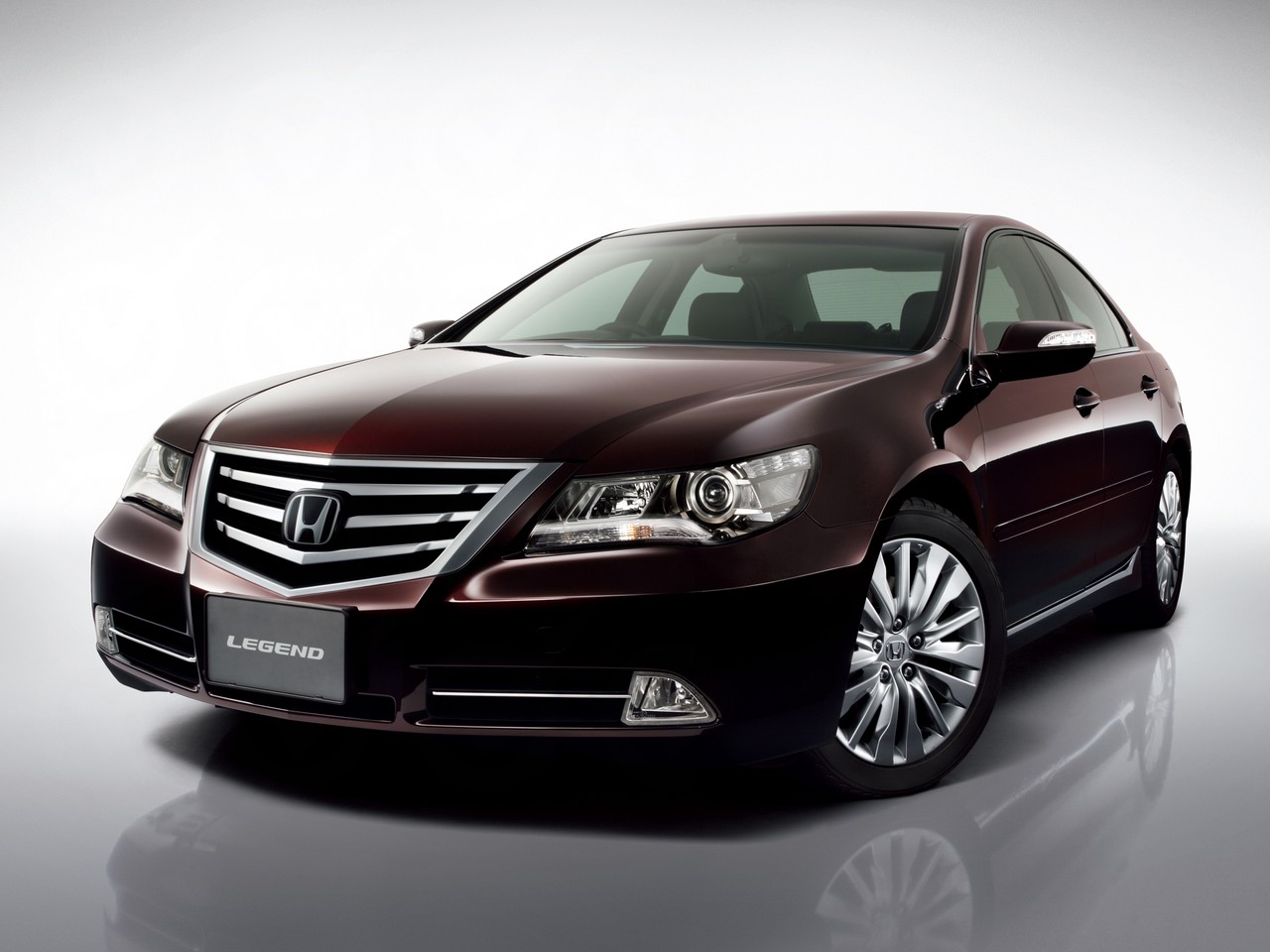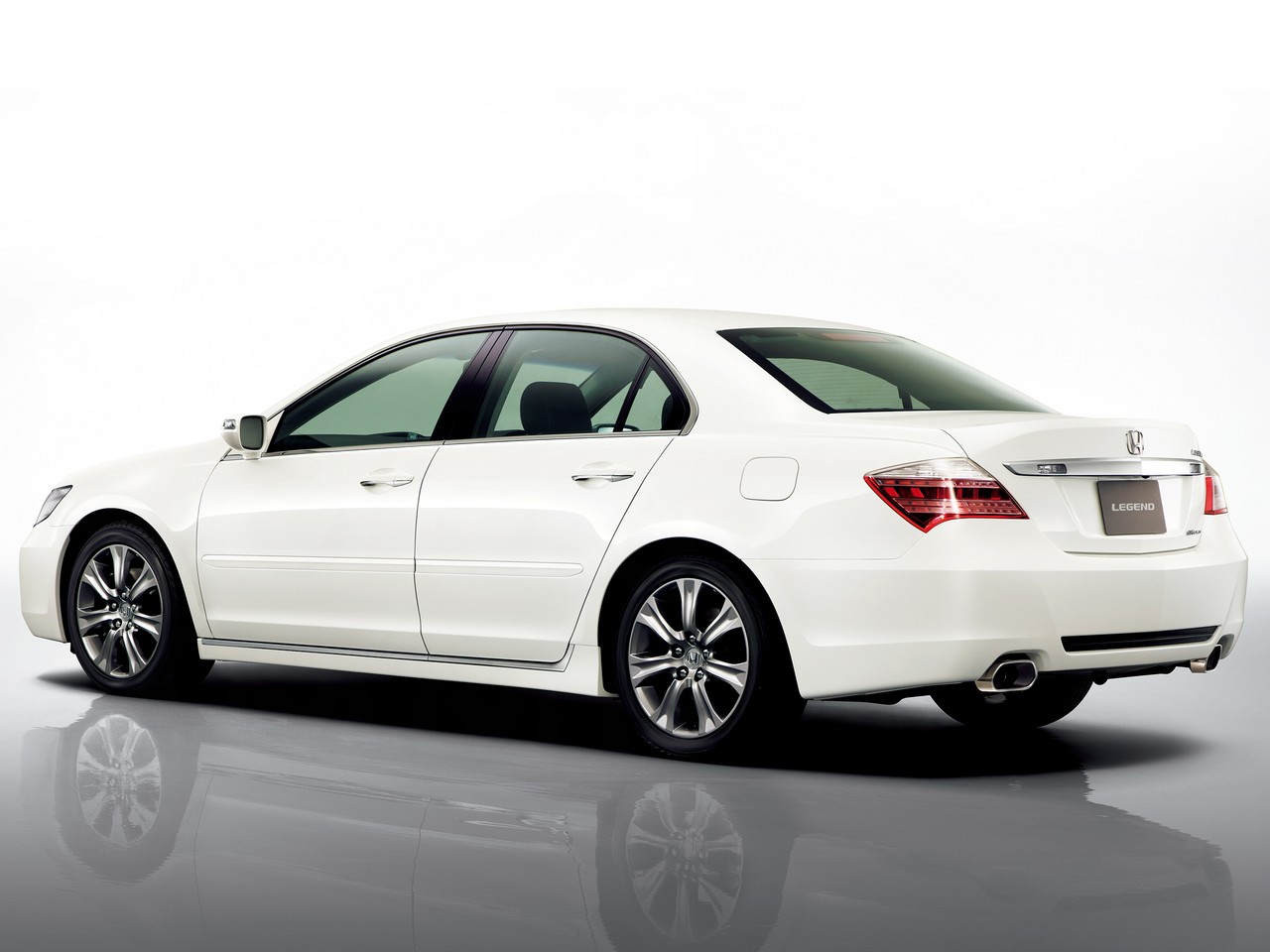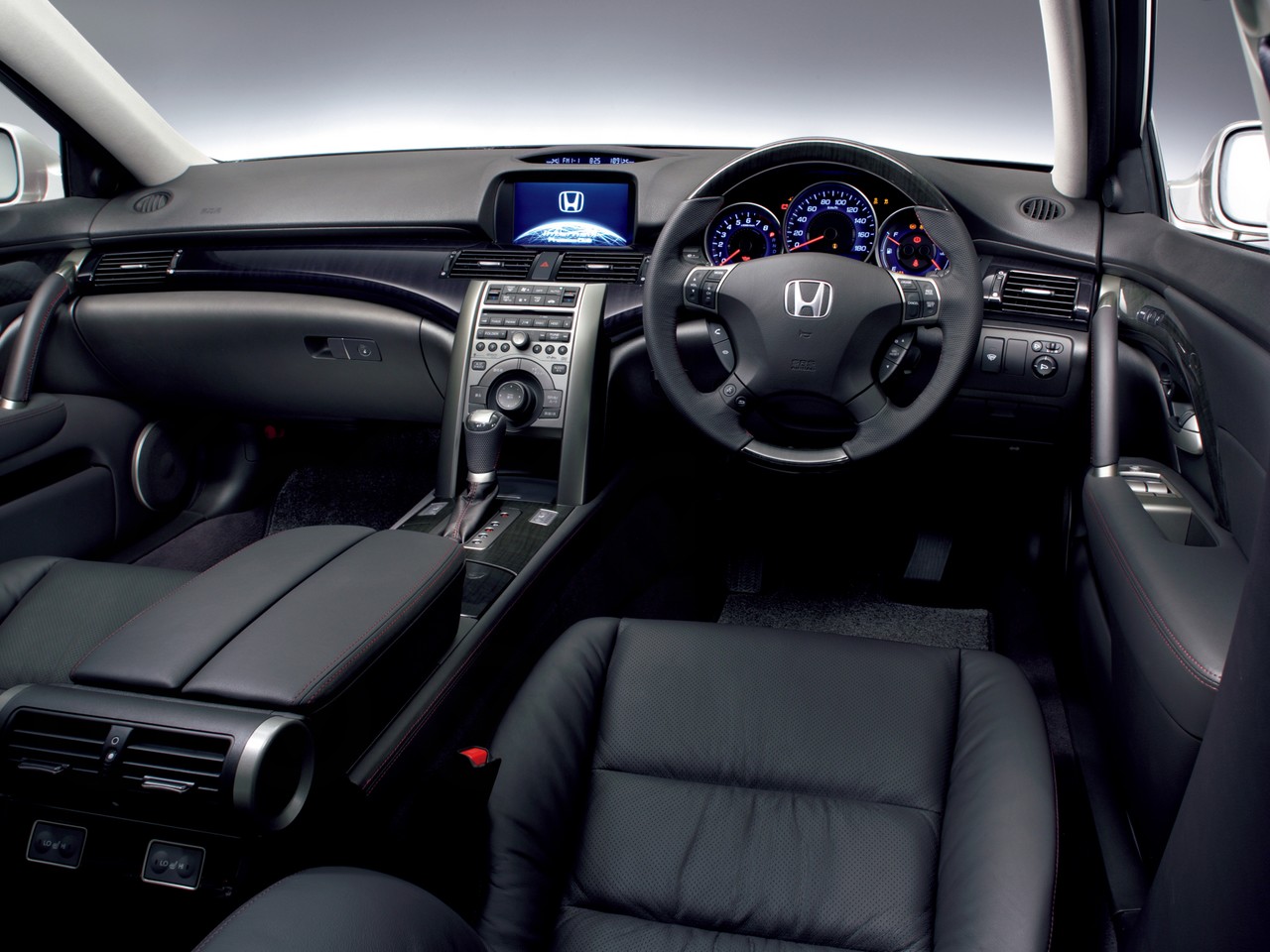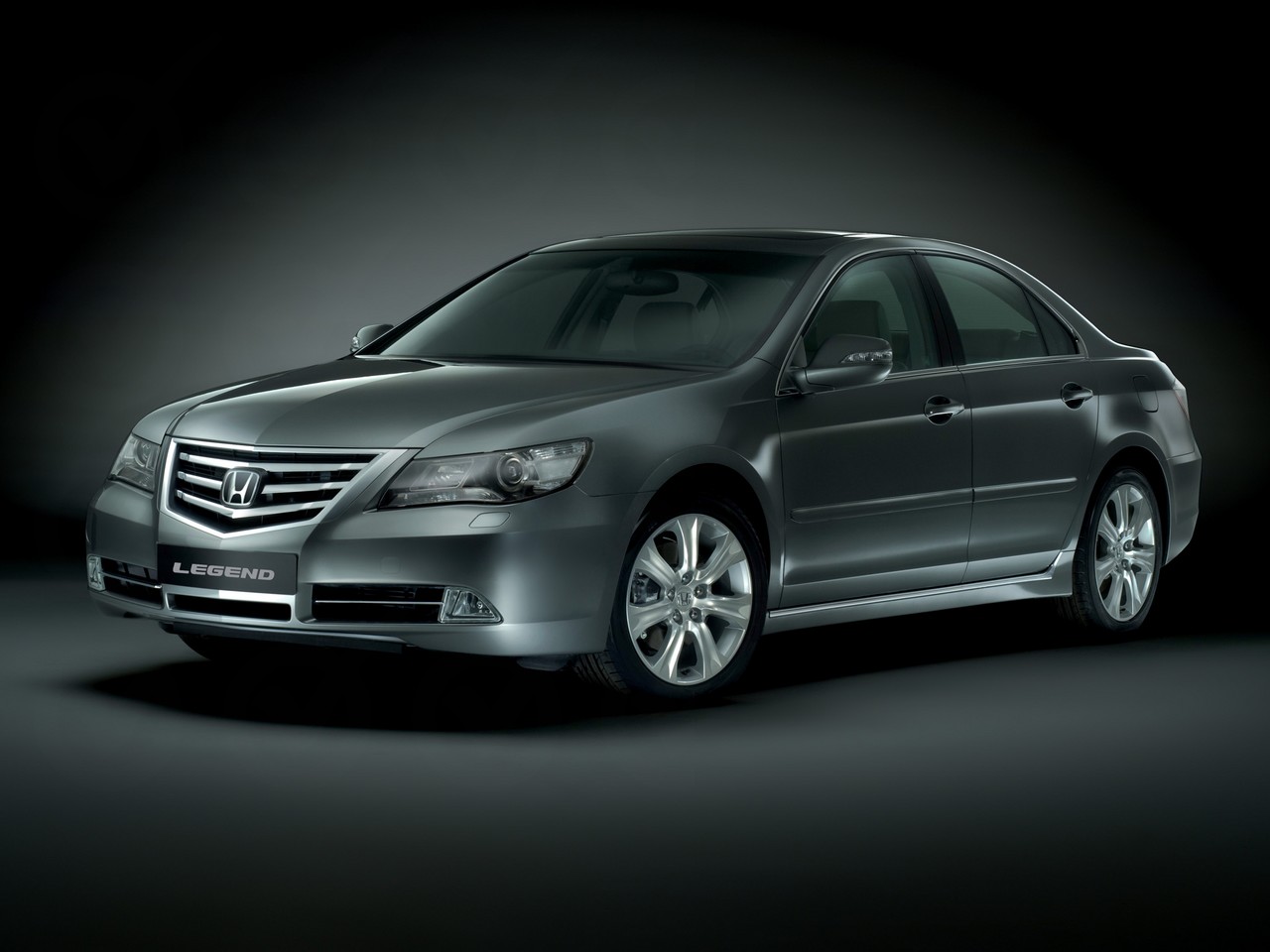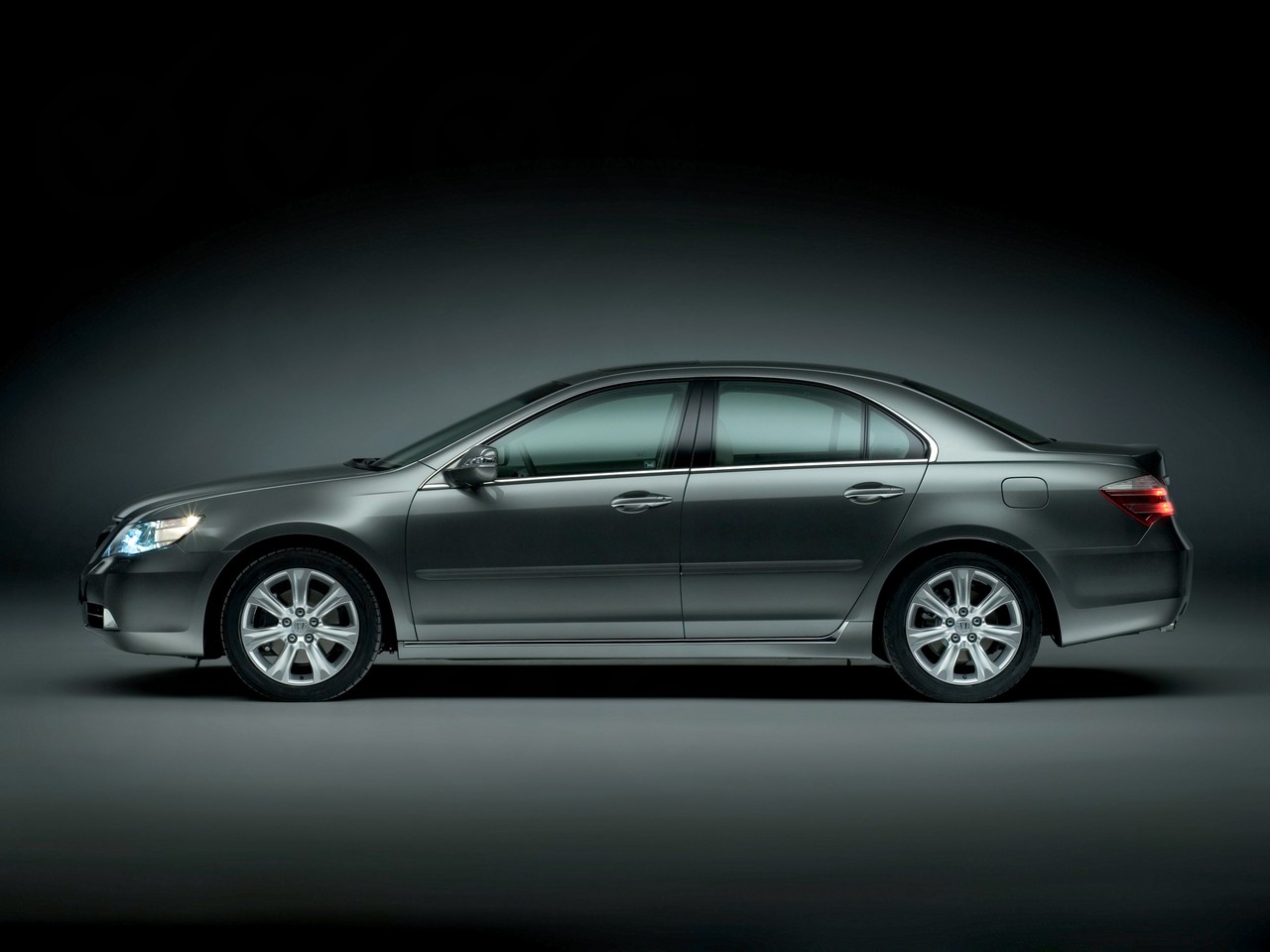
- Refined and responsive V6 engines
- SH-AWD traction contributes to capable handling
- Comfortable ride
- Quiet, well-insulated cabin
- Disappointing satellite navigation system
- Over-assisted steering lacks feel
- High fuel consumption for city driving
- Smaller boot than rivals
Honda KB1 Legend (2006-08)
Overview
Released in August 2006, the Honda KB1 Legend was a large, premium sedan. Manufactured in Sayama, Japan, the KB Legend was powered by a 3.5-litre V6 petrol engine which drove all four wheels via Honda’s SH-AWD all-wheel drive system (see ‘SH-AWD’, below). A five-speed automatic transmission – with steering wheel gearshift paddles – was fitted as standard.
J35A8 V6 engine
The KB1 Legend was powered by Honda’s 3.5-litre J35A8 engine which had a single overhead camshaft and four valves per cylinder. The engine also featured Honda’s VTEC (Variable Valve Timing and Lift Electronic Control) system which enabled different camshaft profiles to be engaged for both low and high RPM operations. For the J35A8 engine, however, the VTEC only applied to the intake valves. The engine required premium 95 RON unleaded petrol.
Dimensions and suspension
Compared to the KA9 Legend , the KB1 Legend was 38 mm shorter (at 4917mm), 25 mm wider (1847 mm), 20 mm higher (1450 mm) and had a 110 mm shorter wheelbase (at 2800 mm). Furthermore, the new chassis was approximately one-third stiffer and the body itself had a coefficient of drag of 0.29 Cd.
The KB1 Legend had double wishbone front suspension and multi-link rear suspension (both with coil springs, gas-filled dampers and anti-roll bars).
Active Noise Cancellation
The KB1 Legend introduced an Active Noise Cancellation (ANC) unit developed specifically for the Legend which used two microphones located in the roof console to monitor drivetrain noises entering the cabin and emitted a reverse phase audio signal via the audio system to override unwanted frequencies.
| Engine | Trans. | Peak power | Peak torque | |
|---|---|---|---|---|
| Legend | 3.5-litre petrol V6 | 5sp auto | 217 kW at 6200 rpm | 351 Nm at 5000 rpm |
Super Handling All Wheel Drive (SH-AWD)
Honda’s Super Handling All Wheel Drive System sonsisted of a Torque Transfer Unit, Acceleration Device and Direct Electromagnetic Clutch Systems; these will be considered in turn.
Torque Transfer Unit
A helical gear – attached to the front differential’s ring gear – provided input torque to the Torque Transfer Unit which was bolted directly to the front-mounted transaxle. At all times, the rear wheels received between 30 and 70 per cent of the total engine output. Specifically, however,
- During straight-line cruising and moderate cornering (below half throttle openings), up to 70 per cent of the engine’s torque would be directed to the front wheels;
- In full-throttle straight line acceleration, up to 40 per cent of the engine’s power would be sent to the rear axle; and,
- In hard cornering, up to 70 per cent of the engine’s torque would be directed to the rear wheels. As detailed below, 100 per cent of rear axle torque could be directed to the outside rear wheel and that wheel could be ‘overdriven’ by up to five percent by the Acceleration Device if required.
To identify the above situations, sensors monitored wheel speed rotation, steering angle, yaw rate and lateral g forces.
Acceleration Device
From the Torque Transfer Unit, a lightweight carbon fibre reinforced composite propeller shaft carried power to the ‘Acceleration Device’, a clutch/planetary gear set. It operated in the following manner:
- In straight line driving, the input shaft would be locked with the planetary gear carrier. As such, the input and output shafts of the Acceleration Device would rotate at the same speed.
- When cornering, the carrier could be coupled with the case such that the output shaft could rotate 5.7 per cent faster than the input shaft.
From the Acceleration Device, torque was transferred to the rear axle shafts via a hypoid gear.
Direct Electromagnetic Clutch Systems
On either side of the hypoid gear, two identical ‘Direct Electromagnetic Clutch’ systems determined the torque that was delivered to each rear wheel, providing a limited-slip differential function. Pressure to each clutch was controlled by an electric coil – this would adjust the speed of the sun gear (in the planetary gear) to modulate the torque sent to the wheel.
The amount of torque transmitted to each rear wheel could be varied continuously, from zero to 100 per cent. With the throttle closed when cornering, torque to the outside rear wheel would be varied to change from an inward to an outward yaw moment, providing greater stability. A search coil sensor allowed the ECU to estimate the clutch plate coefficient of friction and adjust the voltage sent to the electromagnetic coil which controlled the clutch.
Safety equipment
Standard safety equipment for the KB1 Legend included dual front airbags, front side airbags, full length curtain airbags (i.e. for front and rear occupants), ABS, electronic brake force distribution, brake assist, electronic stability control, traction control and front seatbelts with pretensioners and load limiters. For pedestrian safety, the Legend was also fitted with a pop-up bonnet which would rise in a collision to cushion a pedestrian’s impact with the bonnet.
Brakes
The Honda KB1 Legend had 320 mm ventilated front brake discs with four-piston calipers and 310 mm ventilated rear brake discs with single-piston calipers.
Euro NCAP crash testing
In Euro NCAP crash testing , the Honda KB1 Legend was received a five star adult occupant protection rating with a score of 33.2 out of 37. In the offset crash test, protection from serious leg injury was marginal for the driver. In the side impact test, there was a one point deduction due to a door opening during the crash. Maximum points, however, were awarded in the pole test.
Features: Honda KB1 Legend
Standard features for the Honda KB1 Legend included 17-inch alloy wheels, a ten speaker sound system with six-stack CD player and MP3/WMA capability, dual zone climate control air conditioning, leather seats, heated and eight-way power adjustable front seats, front and rear fog lamps, cruise control, directional headlights, reversing camera, rain-sensing wipers, two-way power sunroof, a leather-wrapped steering wheel with gearshift paddles, remote central locking, power windows and mirrors, power retractable and heated door mirrors, driver’s seat and steering wheel memory settings, tinted windows, a power adjustable steering wheel (tilt and reach), 12 volt power outlet, trip computer and an immobiliser.
Related links
Honda KB2 Legend (2008-12)
Overview
Released in September 2008, the KB2 Legend featured a new engine, revised suspension and greater refinement. The J35A8 engine was replaced with Honda’s 3.7-litre J37A4 engine which achieved greater fuel efficiency as the VTEC system was adapted for both the intake and exhaust valves (previously intake only).
Visually, the KB2 Legend could be identified by its reshaped aluminium bonnet, bi-xenon headlights, pentagonal grille with three chrome bars, new front and rear bumpers, tail-lights and bootlid with integrated rear spoiler. The suspension was also revised with ‘higher rate’ spring and damping settings.
| Engine | Trans. | Peak power | Peak torque | |
|---|---|---|---|---|
| Legend | 3.7-litre petrol V6 | 5sp auto | 226 kW at 6300 rpm | 370 Nm at 5000 rpm |
Features: KB2 Legend
Compared to its KB1 predecessor, the KB2 Legend was equipped with 18-inch alloy wheels with 245/45 tyres, a ten speaker Bose sound system with auxiliary inputs, satellite navigation, ten-way power adjustable front seats and an ‘acoustic’ (i.e. sound-insulating) windscreen.
Brochures
Related links
- Specifications: Honda KB2 Legend (2011)
- Honda.com: Honda Develops World’s First Super Handling All-Wheel-Drive
- Wikipedia.org: Honda Legend (fourth generation)
